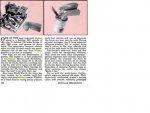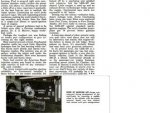it is not the compression ratio, as the compression ratio in the 6.2l is almost the same as our deuces.
it is not the fuel density compensator, that only helps the injection pump with metering fuels of different weight.
IT IS THE DESIGN OF THE ENGINE THAT MAKES IT A MULTIFUEL!!
The MAN combustion process is used to burn other fuels safely. In this process the fuel is introduced into the combustion chamber in a spray rather than a mist. The intake port and valve are configured in such a manner to cause a tremedous swirl of air into the chamber. this swirling air and the fuel stuck to the walls of the bowl allow for a SLOW BURN. The fuel is kept on the walls of the combustion chamber (in the piston itself) to aide in control of the burn rate.
A diesel injects fuel at the point where it will ignite almost imediately due to the heat and combustion. If gasoline were used, it would burn entirely too fast and too hot and destroy the engine very quickly. Even though a diesel engine uses a slower burning fuel as compared to gasoline, it is still considered as a "fast burn" design.
A gasoline engine has the fuel mixed with the air and it is then compressed and ignited with a spark plug vs compression. if you were to run a gasoline engine on diesel, it would likely not run at all. There just isnt enough heat, nor is the fuel at a high enough pressure to be injected properly. Gasoline engines are typically a "fast burn" design as well.
Now because the compression ratio is so high on the detriot/GM 6.2l some may think it will burn anything. And they are partially right. it will burn gasoline, along with the aluminum in the piston if it were ran on gasoline. It can burn other fuels similar to diesel, as most diesel engines will.
This guy is severly mis-informed. But have fun with him, bet a dollar that you can get farther on 10 gallons of gasoline in your deuce than he can on 10 gallons of gasoline in his CUCV. See if he starts to think twice.
I recommend, to anyone who actually cares what a multifuel is actually comprised of, to buy 'The Internal-Combustion Engine in Theory and Practice' vol. 1 & 2 by Charles Fayette and Taylor. This is probably one of the few text books that have any real data on the MAN combustion process.
..."The M.A.N. "Meurer" Combustion system Shows a combustion system developed about 1954 by Maschinenfabrik AugsburgNurnberg A.G. of Germany for small, high-speed engines. It differs from other open chamber engines in being designed so that the fuel spray impinges tangentially on, and spreads over, the surace of a spherical cavity in the piston.
It is known that, except perhaps at light loads, there is some impingement of the spray on the combustion chamber walls in all successful Diesel engines. However, until the advent of the Meurer design it had generally been assumed that fuel spray impingement was undesirable. The theory behind this system is that enough of the spray will ignite before impingement so that the delay period will be normal, while the bulk of the spray will have to evaporate from the cavity walls prior to combustion. Thus, the second stage of the combustion process is slowed down avoiding excessive rates of pressure rise.
In practice this engine gives good perfromance even with fuels of exceedingly poor ignition quality, such as motor gasoline. Its fuel economy appears to be extremely good for an engine of small size. From this fact it may be concluded that the third stage of combustion is not unduly extended, and that spray impingement can be employed with useful results."
There is more data in these two books about the MAN process. I would advise anyone who would like to give advice to others about how a multifuel works, to read these books first.




